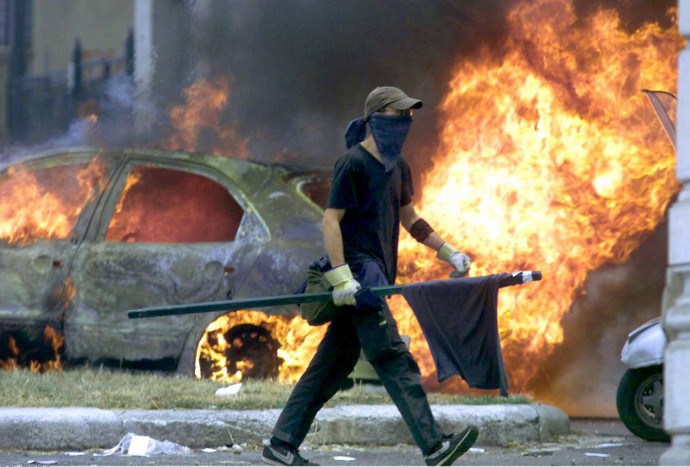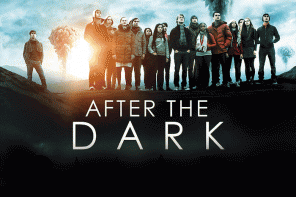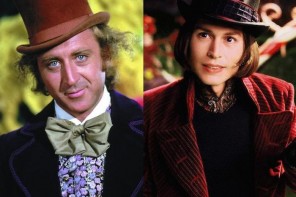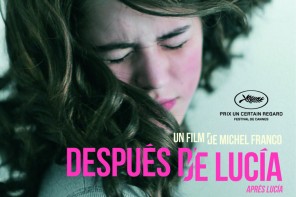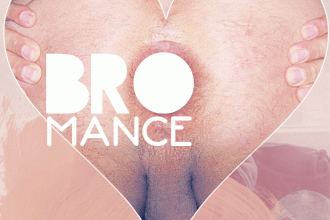Blackblock(2011) by Carlo Augusto Bachschmidt or ‘police violence at its best’.
Blackblock. When you look it up on wikipedia, it states that it is a demonstration technique created in Germany. With the aim being not to be recognized, the protesters wear big dark glasses, hoods or bandanas. The result is an increased feeling of togetherness. No one can be identified so everyone has to stick together. It’s not about being highly organised or breaking everything. It’s more about the fact that, without a face and with everyone in black, everybody is equal. In a demonstration this feeling of togetherness is really important and a basic precedent for the good behaviour of the people.
For the police, the Blackblock is a powerful anarchist group that can have a tremendous influence on the demonstration itself. The police see them as very organized and very dangerous. The ones first targeted are usually those who have travelled hundreds of kilometers to come to the international demonstration.
The documentary Blackblock by Carlo Augusto Bachschmidt perfectly describes the distortion in the understanding of the word. The main bit describes police violence at the Genoa G8 Summit protest in 2008. The film begins with the story of one of the protesters, Muli, who was thirty-one years old when the movie was shot. This Berliner is filmed in his birth city, sharing the history of Berlin’s squats and raising housing prices with the viewer. He describes his life as being in a state of permanent militancy and shares how he was drawn in by big international demonstrations.
The story of police violence begins during the demonstration when the police failed to simply push the demonstrators back and, instead, proceeded to beat them up and spread weird gas that stuck in their brains for the hours to follow. The demonstration was a peaceful one with no intentions of breaking anything. The goal was simply to pass a message through. Some farmers were there, as well as union workers and anarchist groups. A good mix of different people all protesting against a system that took everything they had.
From the very beginning to the very end of the documentary, your only question as a viewer is “Why? Why such violence?”. The documentary clearly shows that the violence is not needed and is done solely to incite fear in people, to scare them off, to tell them that what they are doing is not right and that it is harmful. However, it’s actually the other way around. The demonstration ends, one guy was shot with a bullet to the head, hundreds were injured, dozens very badly. Everyone is waking up from a bad dream in the end with a lot of bruises. What the fuck just happened?
Most of the international demonstrators heard that there was a school where they could sleep legally and for free. Two thirds of the documentary discusses that night. The testimony of several protesters from different countries makes you realize how violent it must have been. With stolen images of the scene, you slowly begin to wonder how such a thing was possible. The policemen were like savage animals that were just set free. Their aim was not to talk or even to kick them out from the house. It was simply to beat everybody up. They were trying to do as much harm as they could and that was a lot of fun for them. A girl describes how they came into the room and kept throwing her against a clothes hook again and again. Another one tells a story about how he saw another guy from the demonstration with an open head wound and how the five policemen that were around him kept on beating him. Blood was in the rooms and corridors. It was everywhere.
The stories in the documentary do not stop here. It gets worse when they go back to the police station and the interrogation begins. One of the thoughts that struck me the most as a viewer was when Muli, the Berliner, realized that he was in the very capable hands of the police. He thought that if they were doing that to him, if they were capable of the denial of his basic rights, he could actually die here and nobody would ever find out. He slowly began to lean towards the idea that he may be about to be murdered at the hands of the very people that were supposed to protect him. It’s the worst thing that can happen to you. Some of them were threatened with rape whilst others were forced to sing pro-Mussolini songs. It was not a good time for anybody apart from the police.
This documentary shows far more than police violence. It shows how wrong things can go when you allow power in the hands of a few. It triggered a sentiment of unfairness and profound inequality. This needs to be seen because people need to know that it can happen anywhere and for no reason. I had to rewatch the film to write this article. It was very hard viewing but, once again, it needs to be spread and seen.
Keep on protesting peacefully and disagree with a system that promotes violence and individuality.

